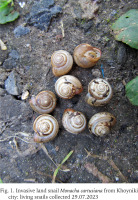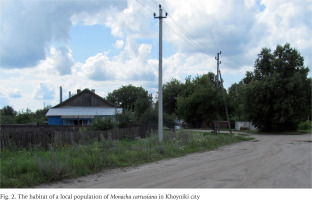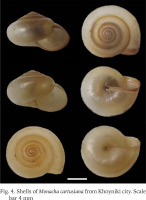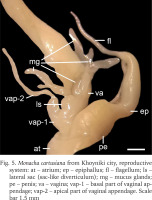INTRODUCTION
The active flow of trade between different countries currently contributes to the expansion of the range of a number of species of terrestrial molluscs and the appearance of alien species in native mollusc faunas. The penetration of species beyond their natural range is associated with both climate change and the unintentional import of individuals together with seedlings, soil and agricultural products (Zemoglyadchuk 2020). The discovery of a new population of the invasive land snail Monacha cartusiana (O. F. Müller, 1774) in the territory of Belarus is reported here; its identity is confirmed by dissection, and it is discussed in relation to other populations in Belarus and the means of dispersal.
MATERIAL AND METHODS
Material was collected in Khoyniki city (51°54′54.1″N, 30°00′38.2″E). Eight living specimens of M. cartusiana was found here on 29.07.2023 (Fig. 1). Snails were found on plant stems by the side of a dirt motor road (Fig. 2). The snails were drowned in water, then fixed in 75% ethanol and have been deposited in the author’s private collection.
The identification of collected material was confirmed by dissection of the reproductive system. The determination of species was carried out using the articles of Hausdorf (2000), Pieńkowska et al. (2015), Gural-Sverlova & Gural (2022, 2023). The main differentiating feature is the presence of a lateral sac (sac-like diverticulum) on the vagina in M. cartusiana. M. claustralis (Rossmässler, 1834), which is a conchological twin of M. cartusiana, does not have such a sac and the vagina has a more elongated and slender shape. As an additional identifying feature, the internal structure of the atrium can be used. According to Pieńkowska et al. (2015), the atrium is “internally rather smooth or with thin, low pleats in M. cartusiana vs a sort of wide, spongy, slightly raised pleat separating penis from vaginal appendix in M. claustralis”. The use of this additional feature is particularly useful during the identification of M. cartusiana specimens that have an atypically long and slender vagina with a slight, sometimes poorly visible lateral sac (Gural-Sverlova & Gural 2022, 2023).
The map (Fig. 3), shows the positions of the new record and those previously published: the first discovery of the species in Brest city, and later records submitted via an online database iNaturalist inaturalist.org):
Fig. 3
A map of distribution of Monacha cf. cartusiana in the territory of Belarus. Designations (1–4) are given in the text (Material and methods)
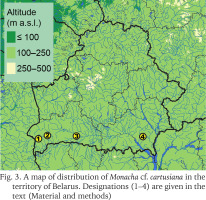
Brest city, Brest region (Zemoglyadchuk 2020);
Kobryn city, Kobryn district, Brest region, 52°12′42.6″N, 24°23′33.9″E, 19.07.2020 (iNaturalist 53604613), 52°12′36.2″N, 24°23′22.8″E, 19.07.2020 (iNaturalist 53603206);
Galeva village, Pinsk district, Brest region, 52°09′30.0″N, 26°05′35.9″E, 21.07.2020 (iNaturalist 53859290);
Khoyniki city, Khoyniki district, Gomel region, 51°54′54.1″N, 30°00′38.2″E, 29.07.2023 (original data).
However, it is worth noting that the identification of specimens recorded previous to this study was not confirmed by examining the genitalia.
RESULTS
Specimens of M. cartusiana collected in Khoyniki city are characterized by a low-cuboid, white or grayish, thin-walled, translucent shell, whose height is 7–9 mm, width 11–12.5 mm (Fig. 4). Aperture is wide, with a thin lip and slightly reflexed brown and red edges, half-covered at the columellar margin. The umbilicus is narrow, its width is about 1/15 of the width of the shell, which is conical, its height slightly larger than the height of the mouth. The shell has 5–6 whorls, the upper part of the last one is 1.5–2 times wider than that of the penultimate one. On the last whorl there are usually weak, not always noticeable dents.
The mantle of living snails is irregularly but strongly marbled with black, brown and white, producing a very different appearance to the living animal as compared with the empty shell.
Genitalia (Fig. 5) were checked only in two specimens, and they are typical for this species, i.e. a penial retractor is absent, the vagina with a sac-like diverticulum, the vaginal appendage is divided into two parts (wide basal and thin apical), and the flagellum is short and thin.
DISCUSSION
The invasive land snail M. cartusiana has a native Southern European-Pontic range and is a xerophilous species (Sverlova et al. 2006, Zemoglyadchuk 2020). Within its natural range, this sub-Mediterranean species is found in short-grass meadows, pastures, including those overgrown with woody and shrubby vegetation, where they can form large populations and cause damage to agriculture, damaging for example, strawberries (Georgiev 2008, Balashov 2016, Ibrahim et al. 2017).
A significant expansion of the range of M. cartusiana has been observed in recent decades in a number of European countries, such as the Czech Republic (Peltanová et al. 2012), Germany (Langner 2003), Ukraine (Balashov 2016, Gural-Sverlova & Gural 2022, 2023, Balashov & Markova 2023), Poland (Górka 2005, Stworzewicz & Górka 2008, Kurek & Najberek 2009, Dembińska & Gołdyn 2011, Pieńkowska et al. 2016). The distribution of M. cartusiana in central European and Balkan countries has been studied in detail by Pieńkowska et al. (2018), and in eastern European countries by Balashov & Markova (2023).
It is believed that the rapid dispersal of M. cartusiana is associated with climate change and human activities (Peltanová et al. 2012). Global warming, combined with the specific microclimate of urbanised areas, has created favourable conditions for the successful survival of heat-loving species of land snails, including M. cartusiana. The habitats of this species are often located near roads, railways and stations, which leads to the reasonable conclusion that the role of rail and road transport is crucial in expanding its range (Oschman 2003, Kwitt & Patzner 2017, Hrdlička & Legátová 2023).
The above factors may have had significant impact on the further expansion of M. cartusiana in a northerly direction, since the existence of stable populations and widespread distribution in the territory of Belarus was considered unlikely until relatively recently (Zemoglyadchuk 2020).
CONCLUSIONS
The results obtained in this study indicate the localised distribution of M. cartusiana in anthropogenic habitats in southern Belarus. At the same time, a new finding of this species in Khoyniki city (Gomel region) expands its known range to the east of the country and documents its further spread.
This article is the first published result of anatomical studies of M. cartusiana from Belarus. This is especially important, since the recent discovery in Western Ukraine, bordering Belarus, of another Monacha species, which is a conchological twin of M. cartusiana (Gural-Sverlova & Gural 2022). In Poland, neighboring Belarus, both species also spread – M. cartusiana and M. claustralis (Pieńkowska et al. 2016).
It appears that penetration of M. cartusiana into the territory of Belarus is by casual import along highways and/or by rail transport from the south and west. This assumption is consistent with the results of research by other specialists (Balashov & Baidashnikov 2012, Balashov & Markova 2023, Gural-Sverlova & Gural 2023). Further expansion of M. cartusiana may be promoted by automobile and railway connections, as well as by the ecological affinities of the species, which prefers ruderal biotopes with low vegetation and often settles in waste ground along roads and in other anthropogenic habitats.

